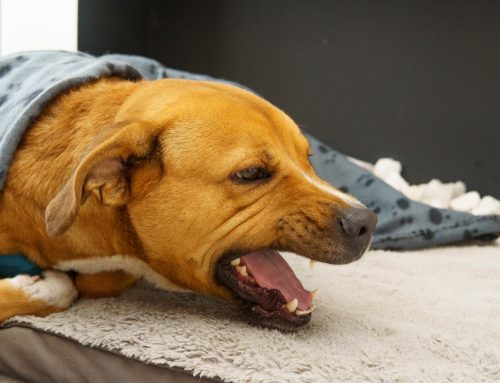Many parents rejoice at the return of the fall season, but their children, especially those with four legs, will likely experience those dreaded back-to-school blues. Store shelves filled with school supplies mean that summer vacations and days lounging with family and friends have come to an end. The transition from leisurely days to scheduled school days can be challenging for all family members, including your pets. Many pets will experience stress and anxiety as the school year approaches, which sometimes can lead to destructive behavior and illnesses. Our Companion Veterinary Clinic team wants to ensure your fur-amily is set up for a successful and seamless school year transition, so follow our five tips to combat your pet’s back-to-school blues.
#1: Recognize your pet’s separation anxiety signs
Like people, pets will respond differently to changes in their environment or routine. Dogs especially find the transition from a busy summer at home to a quiet house challenging, but cats may also experience anxiety when their daily routine or company suddenly changes. Pets who have a history of trauma, abuse, or other anxieties, such as noise aversion, may also have an increased risk for anxiety triggered by a schedule change. Early recognition of separation anxiety signs will allow pet owners to quickly address the problem, and may decrease the chances of more severe behavioral problems. Bring your pet to our Companion Veterinary Clinic veterinarian if they are showing any separation anxiety signs, which may include:
- Mood changes
- Excessive chewing
- Self-trauma
- Howling
- Excessive scratching
- Destructive behavior
- Trembling
- Withdrawing, which is common in cats
- Attempting to escape the home or yard
- Gastrointestinal (GI) problems (i.e., vomiting, diarrhea)
#2: Ease your pet into a new routine
Like the endless shopping trips for school supplies, and school lunch preparations, preparing your pet for the upcoming changes in their routine is critical. Pets, like people, thrive with a consistent routine and environment—many pet owners can set their clock by their pet’s mealtime, potty time, and playtime routines. Easing your four-legged companion into a new routine will decrease their chances of becoming anxious or behaving inappropriately.
In the weeks prior to school starting, leave your pet first for short periods and gradually increase the length of time, so they can get used to the idea of being home alone during the day. Stay calm when you leave, and never make a big deal about your departure, because pets often mimic their owner’s behavior or emotional state, and if you are anxious, they likely will also be anxious. Additionally, keep their important daily activities, including walks, mealtimes, and bedtime, as consistent as possible. Crate training may also provide added comfort for your pet, but patience and gradual acclimation to a crate are imperative.
#3: Make you pet’s alone time a fun time
Teaching your pet to cope with their new routine should include plenty of distractions, like mental and physical enrichment. Making your pet’s alone time a positive experience will decrease their chances of suffering from separation anxiety. Try incorporating any of the following into your pet’s routine when leaving them alone:
- Toys that are treats — Provide your pet with their favorite toy or treat when you leave the house, so that they associate this time with a positive reward. Ensure they don’t have access to these toys or treats when you are home.
- Toys that are puzzles — Give your pet a puzzle toy or Kong filled with their favorite treat to mentally stimulate and distract them during alone time.
- Treats that are hidden — Hide treats around the house for your pet to seek out throughout the day.
- Treats on high — Provide your cat with a window perch facing the backyard or a nearby bird feeder.
- Treats on camera — Use a treat-dispensing camera, like a Furbo, to monitor and praise your pet throughout the day.
#4: Provide your pet with a calm environment and a safe space
Any pet, young or old, and including those who are well-adjusted, are at risk for anxiety when their daily routine suddenly changes. Providing your pet with a calm environment and a safe retreat is vital, especially for cats, so that they can adjust to a less active environment. Place your pet’s bed, favorite toy, treat, and their food and water in a room or space—which can be their crate—where they can feel safe to rest during school hours. Additionally, leaving a clothing article that has your scent can provide additional comfort and serve as a reminder that you will be returning home. Other calming tools for pets may include:
- Pressure wraps — Placing a ThunderShirt, which provides gentle pressure around your pet’s torso, can aid with noise aversion or other anxieties.
- Music — Playing pet-specific calming music can make the quiet house less stressful.
- Pet-specific hormones — Spraying Adaptil or Feliway can promote a calm environment
#5: Bring your pet for a back-to-school veterinary examination

Your pet’s anxiety signs can mimic other diseases, so bring them for a veterinary examination to ensure they have no underlying medical problems. For pets with severe anxiety signs, our Companion Veterinary Clinic veterinarian may recommend a light sedative or serotonin-increasing medication to ease their discomfort. We may also recommend a consultation with a board-certified animal behaviorist, who can provide additional behavior modification tools and treatments.
If you suspect your pet is experiencing back-to-school blues, call our Companion Veterinary Clinic office and schedule them for an appointment. Also, now is a good time for their wellness exam, not only for their anxiety, but also to ensure they are in good overall health.







Leave A Comment